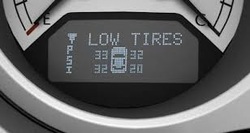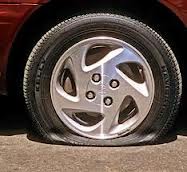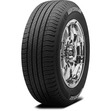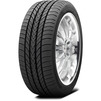 Shop for TPMS at Tire Rack.
Shop for TPMS at Tire Rack.Tire Pressure Monitoring Systems (TPMS)
Tires are composed of alternating layers of fabric and steel encased in rubber. When tires are subjected to variable degrees of pressure (such as being over inflated or under inflated), the layers expand causing the cords to stretch. This weakens the adhesion between the adjacent layers. If the tire continues to run while low on pressure, the layers undergo repeated cycles of disruption and the tire weakens.
Studies have shown that it is a common practice for drivers to drive with a tire low on pressure without even realizing it. According to statistics, every one in four drivers drives a vehicle with tires low on pressure.
To address this danger on the road, federal legislation has made tire pressure monitoring systems mandatory for all vehicles made after 2007. The purpose of implementing these systems is so drivers receive a warning when the tires are low on pressure.
Overview- Direct vs Indirect
Direct tire pressure monitoring systems are created by attaching sensors / transmitters to the wheels. The in vehicle receiver warns the driver whenever the tire pressure falls below a predetermined level. Direct systems are much more accurate and reliable when compared to indirect tire pressure monitoring system. They are even capable of indicating which tire has been affected.
Indirect tire pressure monitoring systems use wheel speed sensors (through Antilock Brake Systems) to assess one tires rotational speed versus each of the other wheels. When a tire has low pressure, the rotations per mile will decrease as compared to that of the other three tires, which will send an alert to the computer. If pressure of all the tires simultaneously decreases then the indirect system is ineffective giving inaccurate readings (except for TPMS in Audi 2009 plus models and volkvagon 2010 plus models).
Direct tire pressure monitoring systems:
Direct tire pressure measuring systems measure, quantify and alert the driver and are comparatively more accurate, as sensors are directly placed in the wheels. Some direct systems are able to send alerts to the dashboard which the driver can see. Direct tire pressure measuring systems can detect rapid air loss from the tire which results in low tire pressure. In addition to this the direct system is able to measure gradual air loss over a period of time.
Some aftermarket and original direct pressure monitoring systems are attached to the wheels by means of metal straps. These sensors / transmitters along with their strips are super lightweight, just weighing a couple of ounces. This factor enables them to be placed on light weight truck and car tires.
Indirect tire pressure monitoring systems:
To provide a low cost pressure monitoring system, companies started manufacturing indirect pressure monitoring as an alternative to direct pressure monitoring systems. This enabled vehicle manufacturers to comply with the law while minimizing production cost. Indirect pressure monitoring systems work on the principle of comparison of tires relative difference in rotations per mile. The vehicles antilock brake sensors detect the relative changes in rotational speed when the circumference of the deflated tire is reduced.
Indirect systems have several shortcoming in terms of performance and reliability. The indirect pressure monitoring system fails to convey to the driver which tire is deflating. Also if all tires lose air slowly over time, the system fails to alert the driver. Also this system has been reported to generate false alarms. In these cases drivers start ignoring the tire pressure monitoring system alerts, which then increases the risks to the safety of the driver.
Tires are composed of alternating layers of fabric and steel encased in rubber. When tires are subjected to variable degrees of pressure (such as being over inflated or under inflated), the layers expand causing the cords to stretch. This weakens the adhesion between the adjacent layers. If the tire continues to run while low on pressure, the layers undergo repeated cycles of disruption and the tire weakens.
Studies have shown that it is a common practice for drivers to drive with a tire low on pressure without even realizing it. According to statistics, every one in four drivers drives a vehicle with tires low on pressure.
To address this danger on the road, federal legislation has made tire pressure monitoring systems mandatory for all vehicles made after 2007. The purpose of implementing these systems is so drivers receive a warning when the tires are low on pressure.
Overview- Direct vs Indirect
Direct tire pressure monitoring systems are created by attaching sensors / transmitters to the wheels. The in vehicle receiver warns the driver whenever the tire pressure falls below a predetermined level. Direct systems are much more accurate and reliable when compared to indirect tire pressure monitoring system. They are even capable of indicating which tire has been affected.
Indirect tire pressure monitoring systems use wheel speed sensors (through Antilock Brake Systems) to assess one tires rotational speed versus each of the other wheels. When a tire has low pressure, the rotations per mile will decrease as compared to that of the other three tires, which will send an alert to the computer. If pressure of all the tires simultaneously decreases then the indirect system is ineffective giving inaccurate readings (except for TPMS in Audi 2009 plus models and volkvagon 2010 plus models).
Direct tire pressure monitoring systems:
Direct tire pressure measuring systems measure, quantify and alert the driver and are comparatively more accurate, as sensors are directly placed in the wheels. Some direct systems are able to send alerts to the dashboard which the driver can see. Direct tire pressure measuring systems can detect rapid air loss from the tire which results in low tire pressure. In addition to this the direct system is able to measure gradual air loss over a period of time.
Some aftermarket and original direct pressure monitoring systems are attached to the wheels by means of metal straps. These sensors / transmitters along with their strips are super lightweight, just weighing a couple of ounces. This factor enables them to be placed on light weight truck and car tires.
Indirect tire pressure monitoring systems:
To provide a low cost pressure monitoring system, companies started manufacturing indirect pressure monitoring as an alternative to direct pressure monitoring systems. This enabled vehicle manufacturers to comply with the law while minimizing production cost. Indirect pressure monitoring systems work on the principle of comparison of tires relative difference in rotations per mile. The vehicles antilock brake sensors detect the relative changes in rotational speed when the circumference of the deflated tire is reduced.
Indirect systems have several shortcoming in terms of performance and reliability. The indirect pressure monitoring system fails to convey to the driver which tire is deflating. Also if all tires lose air slowly over time, the system fails to alert the driver. Also this system has been reported to generate false alarms. In these cases drivers start ignoring the tire pressure monitoring system alerts, which then increases the risks to the safety of the driver.
|
Concerns:
There is a large percentage of under inflation allowed by tire pressure monitoring systems before an alert pops up on the dashboard. A driver of an automobile that calls for 35 psi may not be alerted until the tire pressure falls below 26 psi depending on the specific type of monitoring system which is integrated in the car. Similarly a light truck driver who's vehicle calls for 80 psi may not be alerted until the tire pressure falls below the mark of 60 psi. In both instances it is evident that there is significant decrease in load capacity. So the monitoring systems are to some extent still compromising the safety of the driver not alerting them soon enough. Conclusion: There is definitely room for improvement in the mechanics of low pressure tire monitoring systems. Law definitely needs to reassess its requirements that it has set for low pressure tire monitoring systems to improve driver safety. Nevertheless these systems are still the best safety devices, though unpredictable at times. Drivers must also remain alert, not ignoring the systems alerts, and must pull over to check the tires as there is no substitute for common sense when it comes to checking tire pressures. |
All Season Performance Tires
Excellent response and handling in wet and dry conditions, as well as light snow.
Excellent response and handling in wet and dry conditions, as well as light snow.
Performance Summer Tires
Low profile tires provide great handling and traction for both dry and wet conditions
Low profile tires provide great handling and traction for both dry and wet conditions







